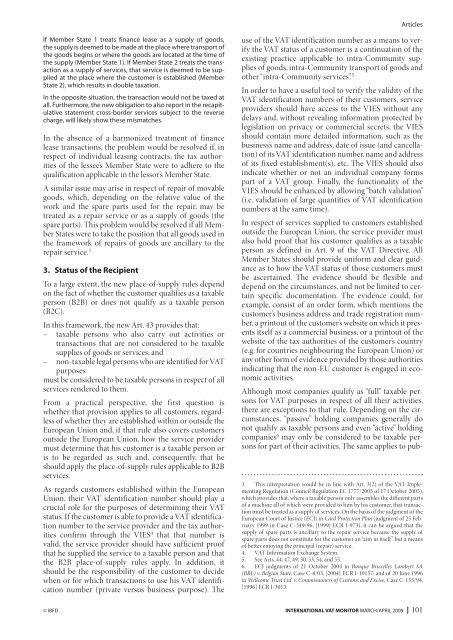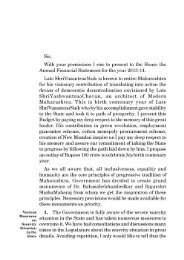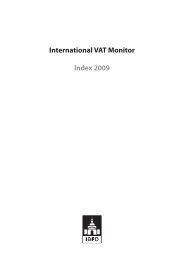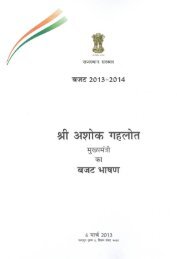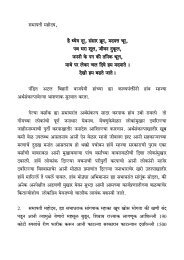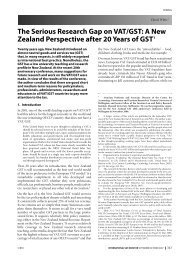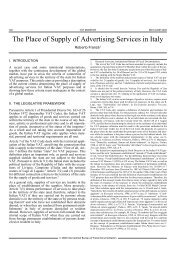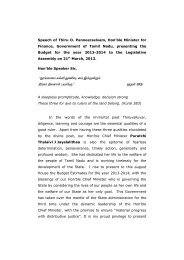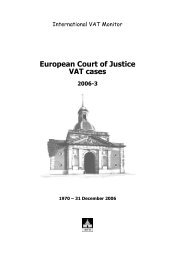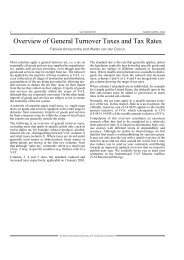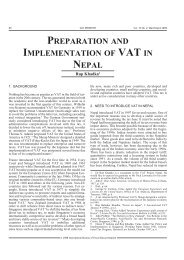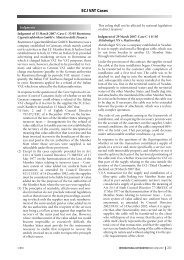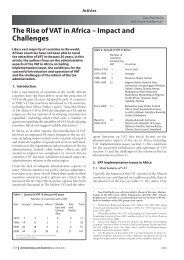The New EU Place-of-Supply Rules from a ... - empcom.gov.in
The New EU Place-of-Supply Rules from a ... - empcom.gov.in
The New EU Place-of-Supply Rules from a ... - empcom.gov.in
Create successful ePaper yourself
Turn your PDF publications into a flip-book with our unique Google optimized e-Paper software.
If Member State 1 treats f<strong>in</strong>ance lease as a supply <strong>of</strong> goods,<br />
the supply is deemed to be made at the place where transport <strong>of</strong><br />
the goods beg<strong>in</strong>s or where the goods are located at the time <strong>of</strong><br />
the supply (Member State 1). If Member State 2 treats the transaction<br />
as a supply <strong>of</strong> services, that service is deemed to be supplied<br />
at the place where the customer is established (Member<br />
State 2), which results <strong>in</strong> double taxation.<br />
In the opposite situation, the transaction would not be taxed at<br />
all. Furthermore, the new obligation to also report <strong>in</strong> the recapitulative<br />
statement cross-border services subject to the reverse<br />
charge, will likely show these mismatches.<br />
In the absence <strong>of</strong> a harmonized treatment <strong>of</strong> f<strong>in</strong>ance<br />
lease transactions, the problem would be resolved if, <strong>in</strong><br />
respect <strong>of</strong> <strong>in</strong>dividual leas<strong>in</strong>g contracts, the tax authorities<br />
<strong>of</strong> the lessee’s Member State were to adhere to the<br />
qualification applicable <strong>in</strong> the lessor’s Member State.<br />
A similar issue may arise <strong>in</strong> respect <strong>of</strong> repair <strong>of</strong> movable<br />
goods, which, depend<strong>in</strong>g on the relative value <strong>of</strong> the<br />
work and the spare parts used for the repair, may be<br />
treated as a repair service or as a supply <strong>of</strong> goods (the<br />
spare parts). This problem would be resolved if all Member<br />
States were to take the position that all goods used <strong>in</strong><br />
the framework <strong>of</strong> repairs <strong>of</strong> goods are ancillary to the<br />
repair service.<br />
3. Status <strong>of</strong> the Recipient<br />
To a large extent, the new place-<strong>of</strong>-supply rules depend<br />
on the fact <strong>of</strong> whether the customer qualifies as a taxable<br />
person (B2B) or does not qualify as a taxable person<br />
(B2C).<br />
In this framework, the new Art. 4 provides that:<br />
– taxable persons who also carry out activities or<br />
transactions that are not considered to be taxable<br />
supplies <strong>of</strong> goods or services; and<br />
– non-taxable legal persons who are identified for VAT<br />
purposes<br />
must be considered to be taxable persons <strong>in</strong> respect <strong>of</strong> all<br />
services rendered to them.<br />
From a practical perspective, the first question is<br />
whether that provision applies to all customers, regardless<br />
<strong>of</strong> whether they are established with<strong>in</strong> or outside the<br />
European Union and, if that rule also covers customers<br />
outside the European Union, how the service provider<br />
must determ<strong>in</strong>e that his customer is a taxable person or<br />
is to be regarded as such and, consequently, that he<br />
should apply the place-<strong>of</strong>-supply rules applicable to B2B<br />
services.<br />
As regards customers established with<strong>in</strong> the European<br />
Union, their VAT identification number should play a<br />
crucial role for the purposes <strong>of</strong> determ<strong>in</strong><strong>in</strong>g their VAT<br />
status. If the customer is able to provide a VAT identification<br />
number to the service provider and the tax authorities<br />
confirm through the VIES4 that that number is<br />
valid, the service provider should have sufficient pro<strong>of</strong><br />
that he supplied the service to a taxable person and that<br />
the B2B place-<strong>of</strong>-supply rules apply. In addition, it<br />
should be the responsibility <strong>of</strong> the customer to decide<br />
when or for which transactions to use his VAT identification<br />
number (private versus bus<strong>in</strong>ess purpose). <strong>The</strong><br />
© IBFD INTERNATIONAL VAT MONITOR MARCH/APRIL 2009<br />
Articles<br />
use <strong>of</strong> the VAT identification number as a means to verify<br />
the VAT status <strong>of</strong> a customer is a cont<strong>in</strong>uation <strong>of</strong> the<br />
exist<strong>in</strong>g practice applicable to <strong>in</strong>tra-Community supplies<br />
<strong>of</strong> goods, <strong>in</strong>tra-Community transport <strong>of</strong> goods and<br />
other “<strong>in</strong>tra-Community services”.<br />
In order to have a useful tool to verify the validity <strong>of</strong> the<br />
VAT identification numbers <strong>of</strong> their customers, service<br />
providers should have access to the VIES without any<br />
delays and, without reveal<strong>in</strong>g <strong>in</strong>formation protected by<br />
legislation on privacy or commercial secrets, the VIES<br />
should conta<strong>in</strong> more detailed <strong>in</strong>formation, such as the<br />
bus<strong>in</strong>ess’s name and address, date <strong>of</strong> issue (and cancellation)<br />
<strong>of</strong> its VAT identification number, name and address<br />
<strong>of</strong> its fixed establishment(s), etc. <strong>The</strong> VIES should also<br />
<strong>in</strong>dicate whether or not an <strong>in</strong>dividual company forms<br />
part <strong>of</strong> a VAT group. F<strong>in</strong>ally, the functionality <strong>of</strong> the<br />
VIES should be enhanced by allow<strong>in</strong>g “batch validation”<br />
(i.e. validation <strong>of</strong> large quantities <strong>of</strong> VAT identification<br />
numbers at the same time).<br />
In respect <strong>of</strong> services supplied to customers established<br />
outside the European Union, the service provider must<br />
also hold pro<strong>of</strong> that his customer qualifies as a taxable<br />
person as def<strong>in</strong>ed <strong>in</strong> Art. 9 <strong>of</strong> the VAT Directive. All<br />
Member States should provide uniform and clear guidance<br />
as to how the VAT status <strong>of</strong> those customers must<br />
be ascerta<strong>in</strong>ed. <strong>The</strong> evidence should be flexible and<br />
depend on the circumstances, and not be limited to certa<strong>in</strong><br />
specific documentation. <strong>The</strong> evidence could, for<br />
example, consist <strong>of</strong> an order form, which mentions the<br />
customer’s bus<strong>in</strong>ess address and trade registration number,<br />
a pr<strong>in</strong>tout <strong>of</strong> the customer’s website on which it presents<br />
itself as a commercial bus<strong>in</strong>ess, or a pr<strong>in</strong>tout <strong>of</strong> the<br />
website <strong>of</strong> the tax authorities <strong>of</strong> the customer’s country<br />
(e.g. for countries neighbour<strong>in</strong>g the European Union) or<br />
any other form <strong>of</strong> evidence provided by those authorities<br />
<strong>in</strong>dicat<strong>in</strong>g that the non-<strong>EU</strong> customer is engaged <strong>in</strong> economic<br />
activities.<br />
Although most companies qualify as “full” taxable persons<br />
for VAT purposes <strong>in</strong> respect <strong>of</strong> all their activities,<br />
there are exceptions to that rule. Depend<strong>in</strong>g on the circumstances,<br />
“passive” hold<strong>in</strong>g companies generally do<br />
not qualify as taxable persons and even “active” hold<strong>in</strong>g<br />
companies may only be considered to be taxable persons<br />
for part <strong>of</strong> their activities. <strong>The</strong> same applies to pub-<br />
. This <strong>in</strong>terpretation would be <strong>in</strong> l<strong>in</strong>e with Art. (2) <strong>of</strong> the VAT Implement<strong>in</strong>g<br />
Regulation (Council Regulation EC 1777/200 <strong>of</strong> 17 October 200 ),<br />
which provides that, where a taxable person only assembles the different parts<br />
<strong>of</strong> a mach<strong>in</strong>e all <strong>of</strong> which were provided to him by his customer, that transaction<br />
must be treated as a supply <strong>of</strong> services. On the basis <strong>of</strong> the judgment <strong>of</strong> the<br />
European Court <strong>of</strong> Justice (ECJ) <strong>in</strong> Card Protection Plan (judgment <strong>of</strong> 2 February<br />
1999 <strong>in</strong> Case C- 49/9 , [1999] ECR I-97 ), it can be argued that the<br />
supply <strong>of</strong> spare parts is ancillary to the repair service because the supply <strong>of</strong><br />
spare parts does not constitute for the customer an “aim <strong>in</strong> itself ” but a means<br />
<strong>of</strong> better enjoy<strong>in</strong>g the pr<strong>in</strong>cipal (repair) service.<br />
4. VAT Information Exchange System.<br />
. See Arts. 44, 47, 49, 0, , 4, and .<br />
. ECJ judgments <strong>of</strong> 21 October 2004 <strong>in</strong> Banque Bruxelles Lambert SA<br />
(BBL) v. Belgian State, Case C-8/0 , [2004] ECR I-101 7; and <strong>of</strong> 20 June 199<br />
<strong>in</strong> Wellcome Trust Ltd. v. Commissioners <strong>of</strong> Customs and Excise, Case C-1 /94,<br />
[199 ] ECR I- 01 .<br />
101


